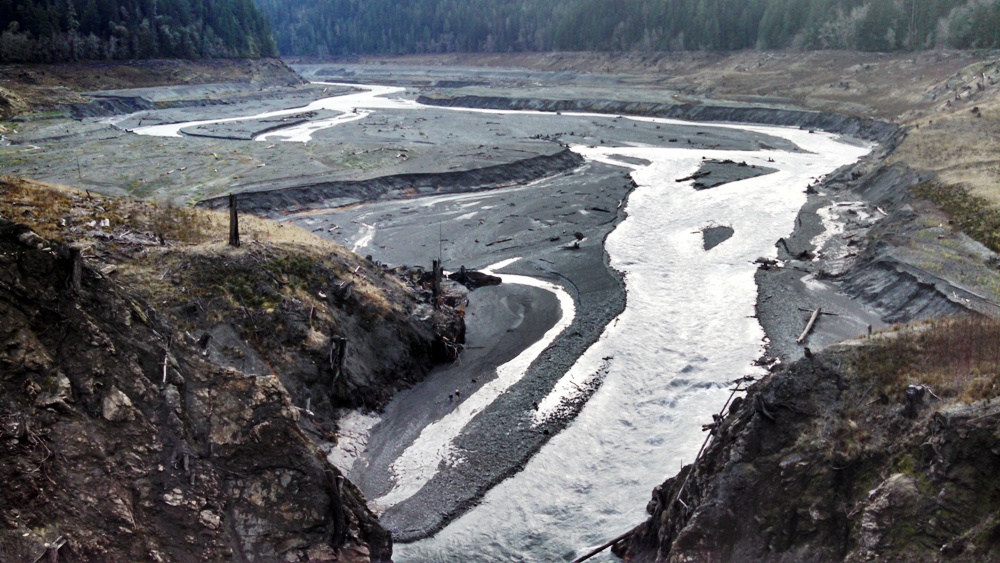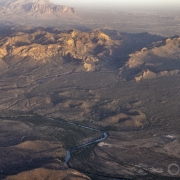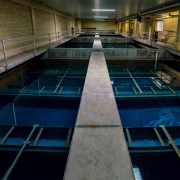Pace of U.S. Dam Removals Accelerates
72 dams were torn down in 2014, a record.

By Brett Walton
Circle of Blue
When the last chunks of concrete from Glines Canyon Dam were ripped from bedrock in August and the Elwha River again touched its old course, the moment marked an engineering and environmental milestone: the completion of the largest dam removal in U.S. history.
Glines Canyon, a 64-meter (210-foot) tall hydropower dam in Washington state that was built in 1927, is now a memory. It is also the most prominent example of an accelerating national trend. More dams than ever before are being removed from waterways. In nearly every American state, the oldest, most useless — and often the smallest — dams are slowly being eliminated.
While countries in the Amazon River Basin, the Indus River Basin, the Mekong River Basin, and other major watersheds are investing in new hydropower dams, governments in Europe and the United States — save for a handful of proposals in the American West — are moving in the opposite direction. Dams built generations ago are producing more costs than benefits. The expense of operating, maintaining, or modernizing older dams with new technology that kills fewer fish exceeds the value of the energy that the dams generate or their capacity to reduce flooding.
–Serena McClain, director of river restoration
American Rivers
According to American Rivers, an advocacy group that tracks U.S. dam removals, 72 dams in 19 states were torn down in 2014, a record. That is roughly double the annual number from 10 years ago. Some 1,185 dams have been removed since 1912, according to the group. The fleet of U.S. dams, however, is still enormous. The Army Corps of Engineers counts at least 87,000 dams in its database.
Two factors explain the quickening pace of removal in the United States, according to Serena McClain, American Rivers’ director of river restoration: awareness and money.
First, communities are growing more comfortable with the idea of demolishing an iconic piece of local infrastructure that may have more than a century of history.
“The most basic challenge is that people don’t like change,” McClain told Circle of Blue. “There is a fear sometimes of what the river will look like when the dam is gone.” Adequate plans must also be written to replace the services – be they energy, flood control, or irrigation – that the dam provided, she added.
Removing dams produces its own benefits. Public safety is enhanced by reducing the risk of a dam failure, and moribund freshwater fisheries are rejuvenated when a segmented river is reconnected.
The second factor is financial. Even if a community is willing, dam removals are technical ventures that require money and expertise. Removing Glines Canyon and a companion dam on the Elwha cost $US 26.9 million as part of a $US 325 million watershed restoration plan. Some dam owners may not have the funds to pay for removal. A few dams may be orphans with a poorly defined legal caretaker, the result of a dam being sold multiple times.
The importance of dedicated funding is evident in Pennsylvania, which demolished 17 dams in 2014, the most in the United States for the twelfth consecutive year. The state is a leader in the field because it has a steady source of state funds, McClain said. The Growing Greener program, established in 1999, has made available more than $US 2 billion for river restoration, abandoned mine cleanup, and farmland conservation, as well as dam removal. The program has provided $US 5.5 million for 129 dam removals since 2000, according to the Pennsylvania Department of Environmental Protection. The money comes from fees levied on natural gas production in addition to appropriations from the state Legislature and federal grants.
“As more funds are available, we see more removals,” McClain said.
Dams of all Designs
The dams removed in 2014 were designed for all purposes. Some generated electricity or turned the wheels of grain mills; others irrigated farmland or supplied municipal water systems. Nearly all were built before World War Two, and one was erected during the Civil War, in 1861.
Most of the dams were small, no taller than a grown man. Projects as monumental as the Glines Canyon removal — which took more than two decades to come to fruition — are rare because of their expense and technical complexity. Larger dams also may produce significant amounts of hydropower or offer other economic benefits such as irrigation or flood control that increase the number of parties interested in preserving the structure.
Nonetheless, McClain expects the number of ex-dams to rise. American Rivers set a goal of 75 dam removals for 2015.
Brett writes about agriculture, energy, infrastructure, and the politics and economics of water in the United States. He also writes the Federal Water Tap, Circle of Blue’s weekly digest of U.S. government water news. He is the winner of two Society of Environmental Journalists reporting awards, one of the top honors in American environmental journalism: first place for explanatory reporting for a series on septic system pollution in the United States(2016) and third place for beat reporting in a small market (2014). He received the Sierra Club’s Distinguished Service Award in 2018. Brett lives in Seattle, where he hikes the mountains and bakes pies. Contact Brett Walton






 © J. Carl Ganter / Circle of Blue
© J. Carl Ganter / Circle of Blue 


Hi, you reported the variety of uses for the dams removed. Is there a detailed report with this information for each dam? Thanks in advance!
Henrique,
In its list of dams that were removed in 2014, American Rivers describes, when known, the purpose, type, and construction date. Here is a link to that list:
http://99.198.125.162/~circl731/wp-content/uploads/2015/01/AmericanRivers_Dam-List-2014.pdf
American Rivers also has a map with all dams in its database from 1936 to 2014:
http://www.americanrivers.org/initiatives/dams/dam-removals-map/
These data, however, have not been systematically analyzed. Not that I know of at least.
Nice to see this trend. I’ve suggested in the past that power companies “offset” their dam renewal licenses by funding the removal of “equivalent” dams (as chosen by a combination of legal, economic and environmental factors). Any traction for that idea?
David, there are couple instances in which a dam removal “swap” was part of the FERC relicensing process, in which smaller dams in a hydroelectric cascade are torn down as part of the project’s permit renewal. See page 2 of the link below for reference to a case in Wisconsin on the Menominee River:
http://biology.kenyon.edu/courses/envs461/02%2028%20BOWMAN_MARGARET_B%20dam%20removal.pdf